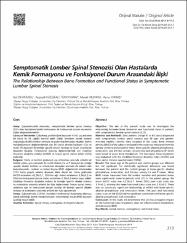The relationship between bone formation and functional status in symptomatic lumbar spinal stenosis
Künye
Devrimsel, G., Turkyilmaz, A.K., Yildirim, M., kirbas, A., (2014).The relationship between bone formation and functional status in symptomatic lumbar spinal stenosis.Türkiye Fiziksel Tıp ve Rehabilitasyon Dergisi, 60(4), 313-317.Özet
Amaç: Çalışmamızdaki amacımız, semptomatik lomber spinal stenozu (LSS) olan hastalarda kemik formasyonu ile fonksiyonel durum arasındaki ilişkiyi değerlendirmektir. Gereç ve Yöntemler: Çalışmaya, polikliniğine başvuran 45-65 yaş arasında 60 hasta ile 30 sağlıklı kontrol dahil edildi. Bireylerin kemik mineral yoğunluğu (KMD) lomber vertebra ve proksimal femurdan ölçüldü. Kemik metabolizmasını değerlendirmek için 24 saatlik idrarda kalsiyum (Ca) ve fosfor (P) düzeyleri ile kemiğe spesifik alkalen fosfataz ve serum osteokalsin düzeyleri ölçüldü. Fonksiyonel durumu değerlendirmek için modifiye Oswestry dizabilite indeksi (mODİ) ve İsviçre spinal stenoz anketi (İSSA) kullanıldı. Bulgular: Hasta ve kontrol grubunun yaş ortalaması arasında anlamlı bir farklılık yoktu, aynı zamanda 24 saatlik idrarda Ca ve P düzeyleri ile kemiğe spesifik alkalen fosfataz ve osteokalsin düzeyleri arasında da anlamlı fark bulunmuyordu. Lomber ve femur boynu KMD değerlerinin ortalamaları LSS'li hasta grupta anlamlı düzeyde daha düşük idi. Hasta grubunda mODİ ortalaması 42,28±3,1, İSSA'nın ağrı skalası ortalaması 3,34±0,2 ve İSSA'nın fonksiyonel durum skalası ortalaması 2,35±0,2 olarak tespit edildi. Modifiye Oswestry dizabilite indeksi ile kemiğe spesifik alkalen fosfataz ve osteokalsin arasında anlamlı bir ilişki bulunamadı. İsviçre spinal stenoz anketinin ağrı ve fonksiyonel durum skalaları ile kemiğe spesifik alkalen fosfataz ve osteokalsin arasında anlamlı bir ilişki saptanmadı.Sonuç: Çalışmamızda LSS'nin, hastaların fonksiyonel durumunu olumsuz olarak etkilediği, kemik metabolizmasını etkilemediği ancak KMD düzeyini azalttığı tespit edildi. Objective: The aim of the present study was to investigate the relationship between bone formation and functional status in patients with symptomatic lumbar spinal stenosis (LSS).Material and Methods: Sixty patients (range 45 to 65 years) diagnosed with symptomatic lumbar spinal stenosis and 30 age- and gendermatched healthy controls were included in this study. Bone mineral density (BMD) of the subjects included in the study was measured from the lumbar vertebra and proximal femur. Bone-specific alkaline phosphatase, osteocalcin, and 24-hour urinary calcium (Ca) and phosphorus (P) levels were tested to assess bone metabolism. The functional status of patients was evaluated with the modified Oswestry disability index (mODI) and Swiss spinal stenosis questionnaire (SSSQ).Results: The mean age of the patient and control groups was different but not significant. No statistically significant difference was found between the patient and the control groups in bone-specific alkaline phosphatase, osteocalcin, and 24-hour urinary Ca and P values. Mean BMD values measured from the lumbar vertebra and proximal femur were significantly lower in patients with LSS. In the patient group, the mean mODI score was 42.28±3.1. Mean SSSQ pain scale score was 3.34±0.2, whereas the mean functional status score was 2.35±0.2. There was no statistically significant relationship of mODI with bone-specific alkaline phosphatase and osteocalcin levels. The pain and functional status scales of the SSSQ had no significant correlation with bone-specific alkaline phosphatase and osteocalcin. Conclusion: In this study, we determined that LSS has a negative impact on the functional status of patients, does not influence bone metabolism, and decreases BMD.


















